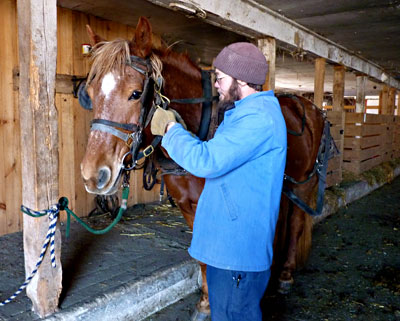 |
| Kenneth Copp prepares his horse Melody and his buggy – more time-consuming than turning a key and stepping on the gas pedal, but also less polluting. English photos. |
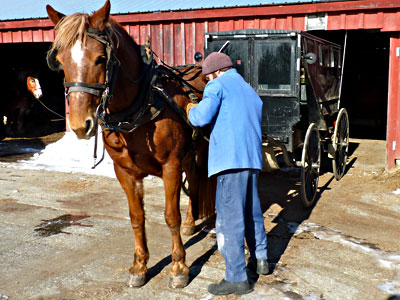 |
By Kenneth Copp
Late one winter morning in March, I pulled in to the Belfast Co-op parking lot with our faithful horse Melody and one of our closed carriages. Having been horse-drawn for more than 12 years, I was not trying to get attention or put on a historical reenactment. It is our way of life now, and I had some business in town that day.
I was not surprised that my arrival created some interest from onlookers, but I was a bit taken aback at the fanfare that commenced. I was barely done tying Mel to the lamppost when two or three folks gathered around, wanting to photograph our horse and carriage, feed Melody carrots and water and stand there oohing and ahhing over her. Admittedly, she is a nice horse, and I am very fond of her, she and I having been traveling companions for thousands of miles over the last decade. But I was thankful that she was getting most of the attention and not I!
We Amish families of Maine’s Unity/Thorndike area are very grateful for the warm response we have received since moving into the area and starting a new settlement here. We have received much encouragement from many of the local folks, more so than in other parts of the country where we have been. This is likely in large part due to the strong environmentally concerned audience and organization we have around here.
Among the comments we most often hear, one especially jars me every time I hear it. It goes something like this: “That’s what we’re going to have to do when the gas price keeps going up like it is.” I always find myself thinking, “Yeah, sure, it’s going to have to get really, really bad before you’ll even attempt to do this!” Then I reflect that a mere 125 years ago or so, this means of transportation was the norm, and had been for thousands of years. Abraham Lincoln traveled in much the same way as Abraham of the Bible thousands of years earlier. In contrast, the average traveler here in North America is skimming over hard-surfaced roads covering in less than an hour what would take a good horse and driver a full day or more, depending on the terrain.
I suppose, upon further thought, most Americans and most peoples of the developed world have accepted the automobile as well as tractors and such as having for all practical purposes replaced the plodding horse. Any further consideration of their use other than for recreational purposes is dismissed as impractical in our modern world. And this despite the escalating fuel costs, let alone the pollution created and loss of life and limb annually.
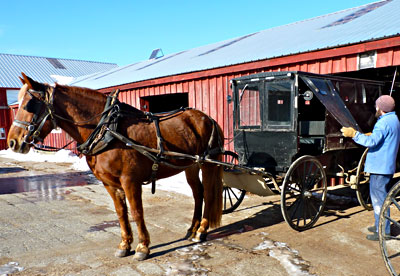 |
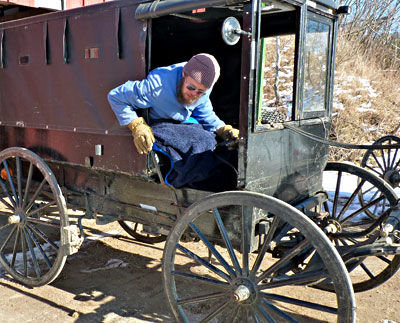 |
| English photos. |
Thankfully, along with the Amish who have religiously clung to farming with horses, a movement is growing all over the country to return to farming with horses. Various excellent publications, such as Small Farmer’s Journal, Rural Heritage, Farming and others, have given the movement an excellent boost. With the burgeoning world population and dwindling fossil fuel resources, many are becoming painfully aware that the modern system we presently take for granted cannot continue much longer. In my limited research, if the society does not radically change its course soon, brutal reality will.
For those who are willing to face reality and put their knowledge into shoe leather, I would like to encourage all who can to take steps now to change their way of life. The Amish do not have an exclusive right to live as they do. I tell folks who express interest in our mode of transportation that they don’t have to be Amish to use a horse and buggy for their transportation. Even though it may look impossible to do so, the way society is set up, if we have faith and do what we can, amazing things can begin to happen.
I would like to envision seeing those who own some land, enough perhaps to pasture a driving horse, to have a small barn to shelter it, and have storage room for enough hay for the winter, as well as a small buggy shed. During the transition period, a motor vehicle could be kept for greater distances, but the goal would be to use the horse and buggy as much as possible, with a radius of 10 to 20 miles determined to be driven only with the horse and buggy, by bicycle or on foot.
Exceptions would exist, as always – for emergencies or the like; however, a strong commitment and vision would be needed to resist the old urge to jump in the car, turn the key, and motor off to town for the newspaper, pizza or other supposed necessity. When you live a horse and buggy lifestyle, your concept of time and distance changes, and you begin to think ahead more and better manage your time. The old adage, “Patch it up, wear it out, make it do or do without” becomes relevant as we live more sustainably.
I envision that if a movement to returning to sustainable transportation can truly arise, that small dying towns would begin to thrive and bustle again. We must wean ourselves from our constant go-go lifestyle and begin to patronize local stores more, to avoid frequent use of the automobile. The Amish have shunned the operation and ownership of motor vehicles to most effectively remove the real possibility of gradually (or quite quickly!) replacing the horse with the car. We do, however, make use of hired drivers who, for a fee, take us distances, or haul items that we can’t practically do with horse and buggy or team and wagon. But even this has become a snare to us, because the tendency is to use these friendly drivers more and more, and the horse and buggy less and less.
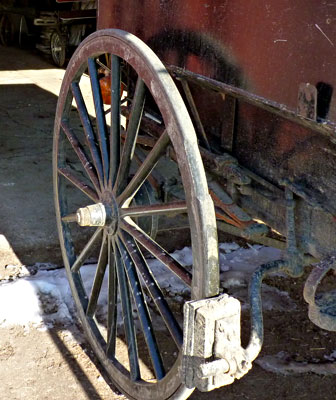 |
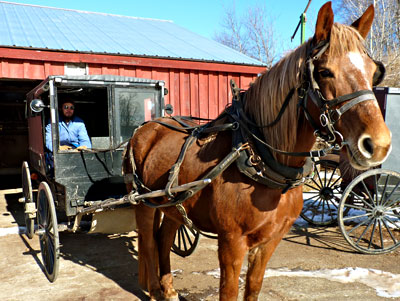 |
| English photos. |
The Maine Organic Farmers and Gardeners Association and the Common Ground Country Fair began with a strong desire of many who saw the desperate need we had to return to the land and begin anew to live and work in harmony with creation. So desperate they were that they attempted what the majority of the modern society considered impossible: to not only garden but even farm organically. These seeds of faith and the human spirit of determination, vision and zeal, despite many obstacles, took root and flourished to the major movement we have today.
I’m reminded of the song often sung in my youth:
It only takes a spark
to set a fire going;
and soon all those around
are warmed up by its glowing.
That’s how it is with God’s love,
once you’ve experienced it;
you spread the news, to those around,
you want to pass it on.
I would like to be at least one of those sparks, to set the fire going in the lives of the many who are already doing a lot to return to sustainable living here on planet earth, yet perhaps need yet another boost or gentle nudge to a closer connection. The use of horses for transportation by the general public is a radical idea in our speed-driven society. It will take some brave souls to spread the vision. What better place than with MOFGA and the Common Ground Fair? The organization could begin with replacing the fossil fuel-consuming tractor shuttles with teams and wagons at the Fair. I believe some very talented and qualified teamsters in the state could well handle this task.
With MOFGA’s newly acquired farmland, it would be only natural and complementary to the Low Impact Forestry committee to initiate a Low Impact Farming program using horsepower instead of tractors – real live teams of nonpolluting workhorses to till and cultivate organically grown crops and bring in the harvest. A large barn could be built to store loose hay, with stables below to house the horses. Younger generations could be taught the beauty and harmony with nature that working with horses versus tractors brings.
If enough youthful souls take up the torch, I believe we can come closer than ever before to a happy and sustainable life here on earth.
About the author: Kenneth Copp is a farmer/furniture-maker who powers his shop with real horsepower and travels extensively with his horse and buggy. See Holli Cederholm’s article about the Copps, “Examples of Amish Family Enterprise: Living Grains Bakery and Locust Grove Woodworks,” in the Dec. 2010-Feb. 2011 issue of The MOF&G.
